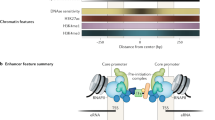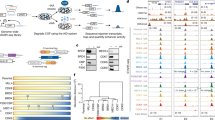Abstract
S/MARs (scaffold/matrix attachment regions) are the DNA regions that are involved in the interaction with the nuclear matrix and are identified by in vitro methods. According to the available information, S/MARs possess an insulating activity, i.e., the ability to block the interaction between the enhancer and promoter in vivo, and are, probably, intact insulators or their fragments. Nevertheless, there is still no direct proof for this correspondence. To obtain additional information on the insulator activity of S/MARs, we selected five DNA fragments of different lengths and affinities for the nuclear matrix from a previously constructed library of S/MARs and tested their ability to serve as insulators. Two of five elements exhibited an insulator (enhancer blocking) activity upon the transient transfection of CHO cells. None of the S/MARs displayed either promoter or enhancer/silencer activities in these cells.
Similar content being viewed by others
Abbreviations
- apoB:
-
apolipoprotein B
- cHS4:
-
chicken β-globin DNase I hypersensitive site 4
- NM:
-
nuclear matrix
- S/MAR:
-
scaffold/matrix attachment region (region of binding to NM)
- scs:
-
specialized chromatin structure
REFERENCES
Chernov, I.P., Akopov, S.B., and Nikolaev, L.G., Bioorg. Khim., 2004, vol. 30, pp. 3–14.
Kuhn, E.J. and Geyer, P.K., Curr. Opin. Cell. Biol., 2003, vol. 15, pp. 259–265.
Namciu, S.J., Blochlinger, K.B., and Fournier, R.E., Mol. Cell. Biol., 1998, vol. 18, pp. 2382–2391.
Kalos, M. and Fournier, R.E., Mol. Cell. Biol., 1995, vol. 15, pp. 198–207.
Nabirochkin, S., Ossokina, M., and Heidmann, T., J. Biol. Chem., 1998, vol. 273, pp. 2473–2479.
Antes, T.J., Namciu, S.J., Fournier, R.E., and Levy-Wilson, B., Biochemistry, 2001, vol. 40, pp. 6731–6742.
Scott, K.C., Taubman, A.D., and Geyer, P.K., Genetics, 1999, vol. 153, pp. 787–798.
Recillas-Targa, F., Bell, A.C., and Felsenfeld, G., Proc. Natl. Acad. Sci. USA, 1999, vol. 96, pp. 14354–14359.
Dunaway, M., Hwang, J.Y., Xiong, M., and Yuen, H.L., Mol. Cell. Biol., 1997, vol. 17, pp. 182–189.
Akopov, S.B., Nikolaev, L.G., Tyrsin, O., Ruzov, A.S., and Sverdlov, E.D., Bioorg. Khim., 1997, vol. 23, pp.727–731.
Chernov, I.P., Akopov, S.B., Nikolaev, L.G., and Sverdlov, E.D., J. Cell. Biochem., 2002, vol. 84, pp. 590–600.
Nikolaev, L.G., Tsevegiyn, T., Akopov, S.B., Ashworth, L.K., and Sverdlov, E.D., Nucleic Acids Res., 1996, vol. 24, pp. 1330–1336.
Nikolaev, L.G., Akopov, S.B., Chernov, I.P., Glotov, B.O., Ashvort, L.K., and Sverdlov, E.D., Dokl. Ross. Akad. Nauk, 1998, vol. 361, pp. 409–411.
Hogga, I. and Karch, F., Development, 2002, vol. 129, pp. 4915–4922.
Donze, D. and Kamakaka, R.T., EMBO J., 2001, vol. 20, pp. 520–531.
Chung, J.H., Bell, A.C., and Felsenfeld, G., Proc. Natl. Acad. Sci. USA, 1997, vol. 94, pp. 575–580.
Ogbourne, S. and Antalis, T.M., Biochem. J., 1998, vol. 331, pp. 1–14.
Sambrook, J., Fritsch, E.F., and Maniatis, T., Molecular Cloning: A Laboratory Manual., 2nd Ed., Cold Spring Harbour; CSHL, 1989.
Chung, J.H., Whiteley, M., and Felsenfeld, G., Cell, 1993, vol. 74, pp. 505–514.
Ruda, V.M., Akopov, S.B., Trubetskoy, D.O., Manuylov, N.L., Vetchinova, A.S., Zavalova, L.L., Nikolaev, L.G., and Sverdlov, E.D., Virus Res., 2004, vol. 104, pp. 11–16.
Author information
Authors and Affiliations
Corresponding author
Additional information
Translated from Bioorganicheskaya Khimiya, Vol. 31, No. 1, 2005, pp. 77–81.
Original Russian Text Copyright © 2005 by Sass, Ruda, Akopov, Snezhkov, Nikolaev, Sverdlov.
Rights and permissions
About this article
Cite this article
Sass, A.V., Ruda, V.M., Akopov, S.B. et al. Regulatory potential of S/MAR elements in transient expression. Russ J Bioorg Chem 31, 70–73 (2005). https://doi.org/10.1007/s11171-005-0009-5
Received:
Revised:
Issue Date:
DOI: https://doi.org/10.1007/s11171-005-0009-5




